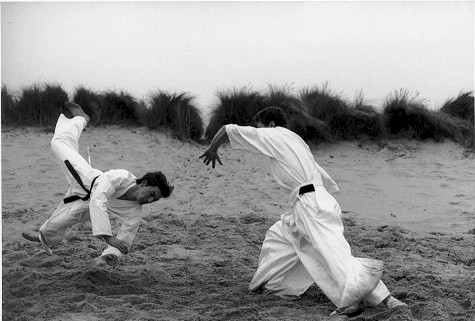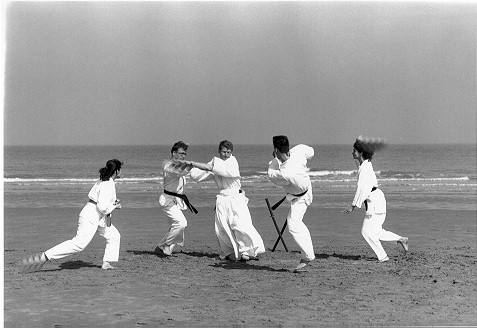![]() STUDIED TECHNIQUES:
STUDIED TECHNIQUES:![]()

Our objective, through these pages, is certainly not to describe in details all the techniques studied in Aïki-Karate-Do. We will give a short outline of the practice of this discipline. The governing idea is the harmony. The practise must work in function from/to each other. Contrary to the disciplines which want that the practise enter in a way or of another in competition, Aïki-Karate-Do, the combat will become increasingly hard, fast and powerful insofar as the partner is able to follow the rate/rhythm.
![]() Attacks :
Attacks :![]()
Inspired by Karate-Do Shotokaï, the attacks very full, are always concluded their. To in no case they could not be blocked. That supposes of course that the practise will have to develop an acute direction of dodging. That also imposes that the attack will be always a function of the practitioner who will undergo it.
That one gives a blow of fist, or a kick, the idea is of going possible further with its attack with the will " to cross " its partner.
![]() Defenses :
Defenses :![]()
The idea of the parade is rather different from that which is usually done. Often, the practise are brought to have to block of a member an attack of arm or leg. But if the attack wants to be powerful and fulgurating, it will be illusory to hope to stop it. Especially if one asks a child to stop Net a technique of " explosive " leg carried out by an adult. However one of the guiding principles is that the different one is more extremely physically than oneself.
The beginners will have to thus banish all bad reflex the incentives to be wanted to protect themselves by blocking an offensive. It will be necessary on the contrary to open for tackling other in order to be in time for, not to block it, but well, while dodging, to deviate very little the trajectory of the attack using a movement of absorption.
![]() Projections :
Projections :![]()
Once again, contrary to much of schools of martial arts, projections in Aïki-Karate-Do will be functions of the partner who attacks. It is not Uké (that which projects) which decides on all its forces to bring Tori (that which attacks) on the ground.

In fact, projection will all the more be fulgurating that the attack will be it. The supply on the ground is not a decision conscious of Uké, it is the logical continuation of an attack which is engulfed in a vacuum created by Uké at the time of its dodging.
For this reason, it is a restricted number of techniques of projection or supplies on the ground which will be studied. Only will be seen the techniques which do not go against the attack itself. Accordingly, the keys and the fixed assets will be to proscribe practice of Aïki-Karate-Do. In the same spirit, the falls will be only seldom dry and attenuated by break-falls, they will be done all in harmony preferably in a way rolled to allow that which falls to be raised without too much of sorrow.
![]() Katas :
Katas :![]()
The coding of certain exercises to two, called katas, has of other goal only to gradually bring the practise in a situation of free combat. This one being very difficult to carry out without there being bad blows, one will thus start by studying in the form of katas the various contextual possibilities of the free combat.
All the katas will thus be done at least to two (katas with five can be studied) and strictly in harmony.
With force of practice, the practise will be detached little by little from the formal and intellectual aspect katas (those sometimes being able to be complex when they require many practise) to arrive to a certain spontaneousness at the time of free attacks.
![]() Free attacks :
Free attacks :![]()
Those also will be, for the beginners, codified and conventional. The governing idea in Aïki-Karate-Do (as in Karate-Do Shotokaï) is that an attack (an attack) cannot be really sincere if that which attack knows well that it will be projected. Therefore it will be asked to him to tackle several times, continuously, sometimes until exhaustion, to be at a given moment, when the fear of projection passes to him, flexibly brought on the ground.
For the more advanced practise, these successive attacks on behalf of Tori will be dodged different way, even in their turning the back.
Several Tori will be able to even attack same Uké, which will have to then smell on which side it is advisable to be best. The free combat will be thus little by little approximate while preserving thanks to the katas the capacity to work in harmony with the (es) attacker. (see photo below)

| Next page |